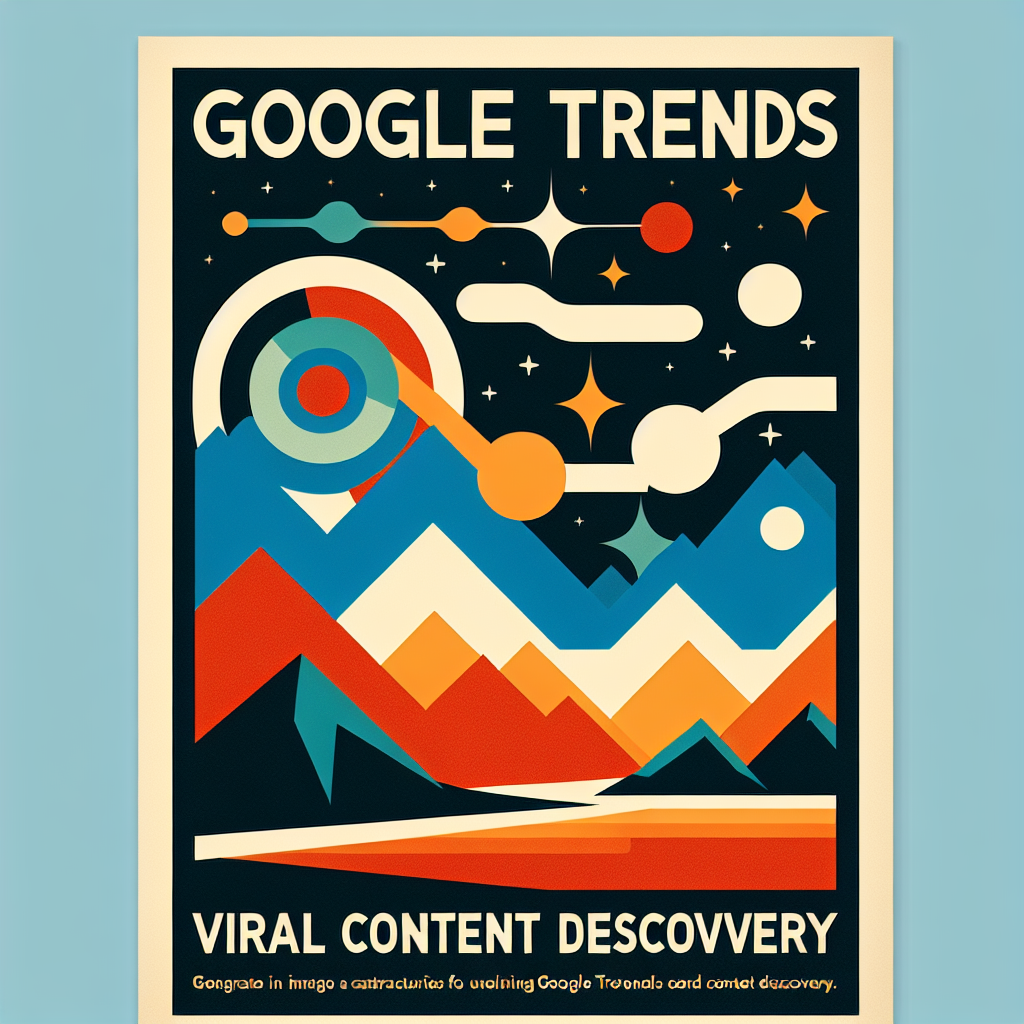### Introduction to Using Google Trends for Content Inspiration
Have you ever wondered how to have your finger on the pulse of what your audience is most interested in? The answer lies in Google Trends, a treasure trove of data that, when used effectively, can guide your content strategy and maximize engagement. In this guide, we’ll teach you how to compile information from Google Trends and use it to craft compelling, timely content. We will cover key features like understanding the Google Trends interface, identifying rising trends, conducting comparative analysis, planning for seasonal content, interpreting data with visual tools, and, of course, learning from successful case studies.
Furthermore, we’ll explore maximizing your potential with the “Interest Over Time” feature and using Google Trends as a tool for market research. We’ll closely examine the legalities of scraping data from Google Trends, along with legally approved methods to use this vast information resource.
So, are you ready to dominate your content game with Google Trends? Let’s get started!
### Using Google Trends for Content Inspiration
#### Navigating the Google Trends Interface
To start using Google Trends, familiarize yourself with its layout:
– Explore the home page to see trending searches and topics.
– Use the search bar to find specific keywords or phrases.
– Filter data by region, time range, categories, and type of search.
Understanding this interface is key to effectively leveraging the available data.
#### Identifying Rising Trends
Spotting emerging trends can help you create content that captures current interests. Here’s how:
– Check the “Trending Searches” section for daily or real-time trends.
– Investigate the “Related Topics” for new perspectives on a subject.
– Utilize the “Related Queries” to find popular search terms linked to your keyword.
These features allow you to tailor your content to what people are currently interested in.
#### Utilizing Comparative Analysis
Comparative analysis helps to find out which topics resonate most with your audience:
– Enter multiple keywords in the search bar to compare their popularity.
– Use the data to focus on the more popular terms for your content.
– Review the “Interest by Region” to tailor content geographically.
This can influence your keyword strategy and help improve SEO.
#### Seasonal Content Planning
Google Trends can inform your content calendar:
– Identify recurring trends to plan seasonal content in advance.
– Understand peak interest times using the historical data available for keywords.
Anticipating these trends will allow your content to be timely and relevant.
#### Data Interpretation with Visual Tools
Google Trends offers visual representations of data, enhancing your understanding:
– Line graphs display interest over time.
– Geo maps show regional interest disparities.
Utilize these tools to better analyze and interpret data for content strategy.
#### Case Studies and Success Stories
Learn from case studies of successful Google Trends implementations:
– Search for articles featuring successful brand stories, like those on [Forbes](https://www.forbes.com/).
– Analyze how these brands used trending data to their advantage.
This can provide valuable insights into effective content strategies.
### Advanced Strategies for Leveraging Google Trends in Content Discovery
#### Utilizing Google Trends for Real-Time Content Engagement
While using Google Trends, engaging with real-time data can significantly enhance your content’s relevance and engagement:
– Monitor real-time data to identify immediate content opportunities.
– Capitalize on sudden spikes in search interest to create timely content that interests users.
– Focus on creating multimedia content like videos or infographics for quick consumption.
Being nimble with real-time data allows for creating high-engagement content that’s topical.
#### Crafting Content Around Sudden Opportunities
Spotting sudden increases in search queries can signal an opportunity for fast-acting content creation:
– Keep an eye on short-term bursts in search queries that indicate trending events or news.
– For example, during a big sports event or product launch, identify keywords associated with the event.
– Draft content rapidly to capitalize on increased search traffic.
Fast responses to sudden opportunities can drive significant website traffic and user engagement.
#### Improving Content Relevance with Historical Trend Analysis
Taking a historical perspective on trends can enhance content relevance and accuracy:
– Examine year-over-year changes in trends to see if a topic is gaining or losing traction.
– Use this analysis for aligning content with long-term trends rather than fleeting spikes.
– Create cornerstone content that builds authority over time by staying aligned with long-lasting trends.
Understanding the bigger picture helps in producing content that maintains relevance beyond momentary spikes.
#### Exploiting Niches with Google Trends Data
Discovering niche topics with Google Trends can diversify and enrich your content spectrum:
– Identify niches within broader topics by analyzing “Related Queries” and “Related Topics.”
– Explore less saturated topics that your competitors might overlook.
– Build a diverse content portfolio that captures varying audience interests.
Focusing on niches can establish your brand as an authority in specialized areas.
#### Enhancing User Experience with Content Localization
Localized content often resonates better with the target audience:
– Leverage the “Interest by Subregion” feature to adapt content for specific cultures and locales.
– Consider language, regional preferences, and cultural nuances in your content creation process.
– Test different variations of localized content to measure performance and engagement.
Fine-tuning content to speak directly to regional audiences enhances user experience and engagement.
#### Optimizing Multi-Channel Strategies with Google Trends
Using Google Trends to inform a multi-channel content strategy can maximize your reach:
– Incorporate trending content themes across various platforms like social media, blogs, e-newsletters, and podcasts.
– Ensure messaging coherence across different channels while tailoring content to suit each medium’s nature.
– Measure success through engagement metrics such as shares, comments, and likes across all platforms.
An integrated approach using trends data ensures consistency and maximizes audience engagement across channels.
For more insights on using Google Trends effectively in your content strategy, you can explore [HubSpot](https://www.hubspot.com/), a well-regarded source for digital marketing best practices.
### Understanding the Legal Aspects of Scraping Google Trends
#### Is It Legal to Scrape Google Trends?
When considering utilizing data from Google Trends, it’s essential to understand the legal implications of scraping data from the platform. Here’s what you need to know:
– Google’s Terms of Service: Google Trends, like other Google products, is subject to Google’s terms of service. These terms prohibit unauthorized access or interference with their services, which includes scraping data.
– API Usage: Google offers an official API for Google Trends, allowing access to its data in a manner compliant with its policies. Utilizing this API is the recommended legal approach to accessing Google Trends data programmatically.
– Possible Consequences: Scraping Google Trends without permission could lead to your IP address being blocked by Google, legal actions, or other repercussions as outlined in their terms of service.
In summary, while scraping Google Trends data directly may seem appealing, using the official API ensures compliance with legal guidelines and Google’s policies.
#### Leveraging Google Trends API for Data Access
For those looking to incorporate Google Trends data into their strategies without risk, using the Google Trends API is the best approach:
– API Features: The API gives access to similar data available on the Trends platform, enabling keyword comparison, historical data analysis, and other functionalities legally and ethically.
– Building Integrations: APIs allow developers to create custom tools and integrations that can harness this data efficiently, allowing for seamless incorporation into marketing and analysis tools.
– Data Compliance: Utilizing the API ensures that all data handling complies with data protection laws and Google’s service agreements.
By leveraging the API, users can access the data they need without risking compliance issues. Use Google’s Developer resources for documentation and guidelines on using the API correctly.
#### Exploring Alternatives to Scraping
If you’re looking for ways to gain insights without direct scraping, consider these alternatives:
– Use of Tools: Various third-party tools and platforms are built upon the Google Trends API. These tools can offer refined analytics and reports based on Trends data without breaching any terms of service.
– Manual Analysis: Regularly visiting the Google Trends platform and manually analyzing data is a straightforward and risk-free approach for smaller scale needs.
Opting for alternatives fosters a more sustainable and legally sound method to harness the valuable insights from Google Trends data. You can find more information and examples of such tools on [TechCrunch](https://www.techcrunch.com/).
### Wrapping Up on Google Trends in Content Strategy
From mapping out user interest to discovering emerging trends, Google Trends serves as a remarkable tool for planning and executing effective content strategies. Its various features like ‘Interest Over Time’, ‘Interest by Region’, and real-time data analysis empower content creators to draft engaging, timely, and relevant content that resonates with their target audience. This comprehensive guide has provided insights into Google’s vast resource for content ideas – Google Trends, the legal implications of data scraping, and the significance of the Google Trends API. Understanding these elements can substantially elevate content marketing strategies and garner improved engagement metrics.
### Frequently Asked Questions – FAQs
#### How can Google Trends be used in content strategy?
Google Trends can be used to identify trending topics, understand regional interests, analyze historical trends, and optimize keyword strategies. This data can be used to create timely and relevant content that resonates with the target audience.
#### What is the ‘Interest Over Time’ feature in Google Trends?
‘Interest Over Time’ is a feature in Google Trends that shows a line graph of search interest for a particular keyword over a specified period. It’s a valuable tool for understanding keyword popularity and planning content accordingly.
#### Is scraping data from Google Trends legal?
Scraping data from Google Trends is prohibited by Google’s terms of service. The recommended legal approach is to utilize their official API for accessing data programmatically.
#### What is the Google Trends API used for?
The Google Trends API allows users to access similar data available on the Trends platform, like keyword comparison and historical data analysis. This data can be used to create custom tools, ensure legal and ethical data handling, and be incorporated into marketing and analysis tools.






